- EUR/USD soars as USD weakens on US ADP jobs and Q3 GDP data.
- The euro area economy grew faster than expected, and the German economy also returned to growth.
- Trump's victory in the US presidential election could have a negative impact on eurozone growth in the long term.
The EUR/USD pair rose sharply following the release of the Eurozone's Q3 GDP figures, which were better than expected, and the euro (EUR) performed well. The report showed that the shared continent expanded faster than expected in the third quarter of this year. The eurozone economy grew by 0.4%, beating expectations and the previously announced 0.2%. Compared to the same period last year, the economic growth rate was 0.9%, compared to 0.6% in the April-June period. Economists had expected the shared continent to grow by 0.8%.
The high growth of the euro area economy was driven by the unexpected economic expansion of its largest country, Germany. Germany's economy unexpectedly rose 0.2% in the third quarter after contracting in the April-June quarter. France's economy grew by 0.4%, as expected, but Italy's economy was flat.
Meanwhile, Germany's preliminary index of consumer prices (HICP) for October exceeded expectations. Annual HICP accelerated at a faster pace to 2.4% from the estimated 2.1% and previously announced 1.8%. The European Central Bank (ECB) will cut interest rates by a larger than usual 50 basis points (bps) in December, following unexpectedly strong third-quarter euro zone GDP and strong German inflation data. expectations have declined. According to market expectations, the probability that the ECB will cut interest rates by 50 basis points after the German data is released will drop from 45% to 22%.
Recent comments from policymakers indicate that they are concerned that inflation will remain low due to slowing economic growth. Meanwhile, with the US presidential election on November 5th, uncertainty regarding the outlook for the Eurozone economy remains. National polls show a tight race between former President Donald Trump and current Vice President Kamala Harris, but traders appear to be pricing in a Trump victory. This victory will have major implications for the eurozone as well.
President Trump has promised to impose a flat 10% tariff on all imports except those from China, which will be subject to even higher tariffs. The threat of tariffs could have a major impact on the eurozone's strong export sector. Investment banking firm Goldman Sachs predicts that if a flat 10% tariff were imposed, the eurozone's GDP would fall by 1%.
Daily digest of market moves: EUR/USD gains on strong euro performance
- EUR/USD rose to near 1.0850 in New York trading on Wednesday as the US dollar (USD) weakened following the release of the United States (US) October ADP job gains and Q3 gross domestic product (GDP) data. However, while the USD's initial reaction was bullish, it could not sustain itself. The US dollar index (DXY), which measures the value of the US dollar against six major currencies, fell to around 104.40.
- The U.S. Bureau of Economic Analysis (BEA) showed the economy expanded by 2.8%, slower than expected and previously announced 3%. Meanwhile, private sector employment statistics were surprisingly strong. The number of new private sector jobs was 233,000, higher than the 115,000 expected and revised upward from the previously announced figure of 159,000, 143,000.
- A solid private job market points to improving economic growth, which should dampen the Fed's dovish bets for the rest of the year. The Fed plans to cut interest rates by 25 basis points (bps) at its November and December policy meetings, according to a Reuters poll from Oct. 23-29.
- Later this week, investors will focus on October non-farm payrolls and ISM Manufacturing PMI data, as well as September Personal Consumption Expenditures Price Index (PCE) data.
Technical analysis: EUR/USD hits a new intraday high near 1.0850

EUR/USD rose to around 1.0850 during North American trading on Wednesday. The common currency pair remains above the upward trend line around 1.0750, which was plotted from the October 3, 2023 low of around 1.0450 on the daily time frame. However, the broader outlook for the major currency pair remains bearish as it remains below the 200-day exponential moving average (EMA) trading around 1.0900. but,
The downside move in the common currency pair began after the double top formation broke on the daily time frame around the September 11 low of 1.1000, resulting in a bearish reversal.
The 14-day Relative Strength Index (RSI) remains in the 20.00-40.00 range, suggesting further downside.
On the downside, if the major currency pair breaks below 1.0750, it could weaken further towards round-level support at 1.0700. Meanwhile, the 200-day EMA near 1.0900 and the psychological reading at 1.1000 emerge as major resistance levels.

